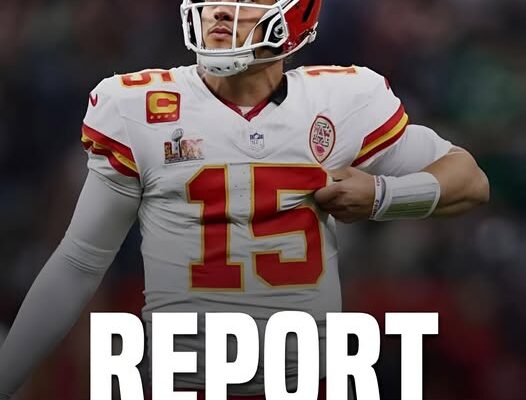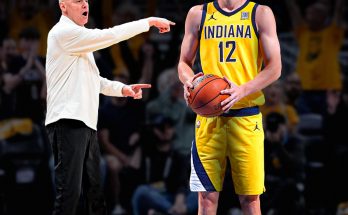After falling short in Super Bowl 59 against the Philadelphia Eagles, the Kansas City Chiefs’ unused three-peat championship merchandise was donated to those in need across several countries, including Ukraine, Mongolia, Georgia, Estonia, and beyond.
After falling short in Super Bowl 59 against the Philadelphia Eagles, the Kansas City Chiefs watched their dreams of a historic three-peat vanish on the grandest stage of American sports. The loss marked the end of a remarkable run for a team that had won back-to-back titles in Super Bowls 57 and 58 and was on the verge of accomplishing something that no team in NFL history had done: win three consecutive Super Bowls. As confetti rained down for the Eagles, the Chiefs were left to reckon with the sting of defeat and the sobering reality that history would not be rewritten in their favor.
But in the shadows of that disappointment, a different kind of impact was taking place—one rooted not in football glory, but in global compassion. As is customary for both teams in the Super Bowl, merchandise proclaiming them as champions is manufactured in advance to be immediately available for sale if they win. That includes hats, shirts, hoodies, towels, and more. But when a team loses, all of that unused “championship” gear becomes obsolete—at least in a commercial sense. Rather than destroy the items or let them sit unused in warehouses, a unique tradition facilitated by humanitarian organizations and in partnership with the NFL ensures that this gear doesn’t go to waste. Instead, it gets sent to people in need around the world.
Following their defeat, the Chiefs’ prematurely printed “three-peat champions” apparel—once intended for exuberant fans—was quietly boxed up, sorted, and prepared for shipment to faraway places where warm clothing is a necessity, and the emotional meaning behind a Super Bowl loss doesn’t carry the same weight. This year, those items found new homes in Ukraine, Mongolia, Georgia, Estonia, and other regions struggling with harsh climates and economic hardship. In many of these countries, families face brutally cold winters with limited access to basic necessities. For them, a soft hoodie or a warm beanie with the Kansas City Chiefs logo isn’t a reminder of defeat—it’s a valuable tool in combating freezing temperatures.
In Ukraine, where the ongoing war has left thousands displaced and infrastructure in ruins, clothing shortages are a real and growing problem. Families that fled war-torn cities often have nothing more than the clothes on their backs. Aid workers in regions like Kharkiv, Lviv, and Zaporizhzhia report that items like the Chiefs’ gear make a tangible difference in people’s lives. What was meant to be celebratory fanwear now serves as practical protection from the elements. Even children, many of whom have never heard of American football or the NFL, smile with gratitude as they slip into oversized hoodies, their parents grateful for any extra warmth in a country wracked by uncertainty and struggle.
Mongolia, known for its harsh winters and vast rural landscapes, is another region where donated Super Bowl gear makes a profound difference. In some areas, temperatures can drop as low as minus 40 degrees Fahrenheit. Nomadic herders and their families often lack access to new clothing, and communities are spread out over great distances, making aid delivery a logistical challenge. Still, thanks to the work of international charities and local volunteers, boxes of Chiefs gear have made it into the hands of those who need it most. A young boy in the Gobi Desert might now wear a Chiefs hoodie while tending to goats, entirely unaware of the significance it once held for millions of sports fans across the ocean.
In the country of Georgia, poverty rates remain high in rural and mountainous areas. The Caucasus Mountains can be as unforgiving as any North American blizzard zone, and warm clothing is a commodity not easily obtained by every family. Chiefs merchandise that never saw the aisles of a Missouri sporting goods store has instead been folded into care packages and distributed to villages nestled deep in the Georgian highlands. For the people there, the red and white logo of the Chiefs holds no connection to a lost Super Bowl—it’s simply a symbol stitched onto clothing that helps them endure another winter.
Estonia, though a member of the European Union, still faces pockets of economic inequality, particularly among its elderly and rural populations. Winters are long and snowy, and heating costs can be a strain on families with limited income. Through local aid groups working with global distribution networks, the Chiefs’ gear reached communities on the outskirts of Tallinn and Narva, and even farther into the country’s remote areas. There, an elderly woman might bundle up in a championship blanket while tending her small garden, or a group of children might laugh as they play in the snow wearing gear emblazoned with the words “Super Bowl Champions.”
For most of the recipients, the gear’s original purpose is irrelevant. What matters is the comfort and security it provides. The tradition of donating this merchandise goes back several years, and it’s administered in part by humanitarian nonprofits like Good360, which works with the NFL to ensure the gear is distributed responsibly and ethically. The goal is not to mislead or confuse communities about sports results, but rather to ensure that the items are never sold or used for profit, and instead serve a purely charitable function.
The NFL, to its credit, has embraced this humanitarian approach with consistency and transparency. What was once a logistical headache—what to do with thousands of articles of incorrect merchandise—has been turned into an opportunity for global good. It’s a testament to how sports, even in moments of loss, can contribute to something much larger than wins and losses.
For Kansas City fans, seeing their team come so close to achieving an unprecedented three-peat only to fall short may remain a sore spot for years to come. The narrative was set. Patrick Mahomes was poised to join an echelon of quarterbacks untouched by even the likes of Tom Brady and Joe Montana. Andy Reid’s legacy was being carved in stone. And a franchise long considered cursed in the postseason had suddenly become a dynasty in real time. All of that felt within grasp—until the Eagles delivered the final blow in Super Bowl 59, ending the Chiefs’ run and resetting the NFL hierarchy once more.
But for all the emotional investment fans put into the game, and for all the marketing dollars spent in anticipation of a different outcome, there is something undeniably beautiful about seeing those same symbols of hypothetical glory doing tangible good across the globe. What may have been a heartbreaking loss in Kansas City becomes a life-sustaining gift in Kyiv. What was once meant for celebration in Arrowhead Stadium becomes solace on the steppes of Mongolia.
This practice also opens a window into how sports, in their broadest sense, are not just entertainment. They are systems of connection. Through the redistribution of these goods, people on opposite sides of the world—who may never watch a single down of American football—become participants in the same event. They may not know the players or the score, but they are touched by the aftermath, by the repurposed remnants of a cultural juggernaut that finds new meaning far from the end zones of the NFL.
There’s also something humbling in it for the athletes and fans alike. For Mahomes, Kelce, Reid, and the rest of the Chiefs, the gear represents what could have been—a championship narrowly missed. But for those who receive it, it represents a rare kindness from people they will never meet. And that shift in perspective—from disappointment to service—is perhaps the most redeeming story of them all.
While the Chiefs will no doubt regroup and chase another title in seasons to come, and while fans will fill stadiums again with hope and anticipation, the true impact of Super Bowl 59’s ending will continue to resonate in the silent gratitude of a Ukrainian father wrapping his daughter in a hoodie, or a Mongolian teenager braving subzero winds in a Super Bowl beanie. The Chiefs may not have won the game, but the gear meant for their victory is now part of a different kind of triumph—one rooted in humanity, dignity, and unexpected generosity.



